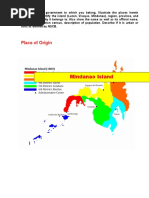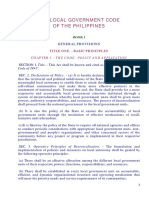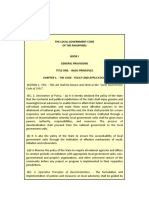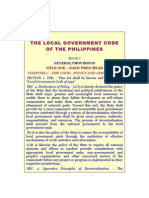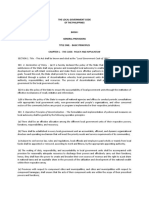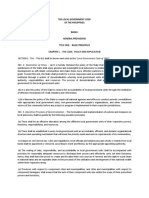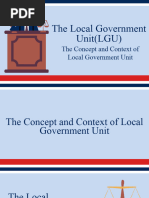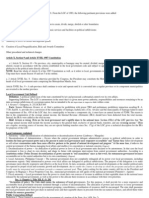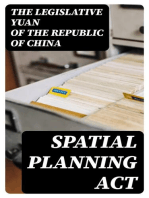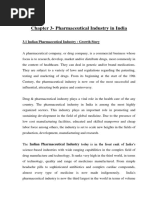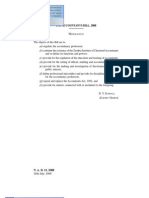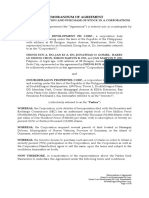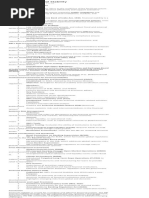Organization of Lgus
Organization of Lgus
Uploaded by
Silma Villanueva-RevesencioCopyright:
Available Formats
Organization of Lgus
Organization of Lgus
Uploaded by
Silma Villanueva-RevesencioCopyright
Available Formats
Share this document
Did you find this document useful?
Is this content inappropriate?
Copyright:
Available Formats
Organization of Lgus
Organization of Lgus
Uploaded by
Silma Villanueva-RevesencioCopyright:
Available Formats
ORGANIZATION OF LGUs 1. Organization of LGUs according to Local Government Code (LGC) of 1991 a.
Roles of the three (3) levels of LGUs 1. PROVINCE The province, composed of a cluster of municipalities, or municipalities and component cities, and has a political and corporate unit of government , serves as a dynamic mechanism for developmental processes and effective governance of local government units within its territorial jurisdiction. 2. MUNICIPALITY/CITY The municipality, consisting of a group barangays, serves primarily as a general purpose government for the coordination and delivery of basic, regular and direct services and effective governance of the inhabitants within its territorial jurisdiction. The city, consisting of more urbanized and developed barangays, serves as a generalpurpose and delivery of basic, regular and different services and effective governance of the inhabitants within its territorial jurisdiction. 3. BARANGAY As the basic political, the barangay serves as the primary planning and implementing unit of government policies, plans, programs, projects and activities in the community, and as a forum wherein the collective views of the people may be expressed, crystallized and considered, and where disputes may be amicably settled. b. Creation and Conversion As a general rule, the creation of a local government unit or its conversion from one level to another level shall be based on verifiable indicators of viability and projected capacity to provide services to wit: 1. Income It must be sufficient based on acceptable standards, to provide for all essential government facilities and services and special functions commensurate with the size of its population, as expected of the local government unit concerned; 2. Population It shall be determined as the total number of inhabitants within the territorial jurisdiction of the local government unit concerned ; and 3. Land Area It must be contiguous, unless it comprises of two or more islands or is separated by a local government unit independent of the others; properly identified by
metes and bounds with technical descriptions; and sufficient to provide for such basic services and facilities to meet the requirements of its populace. Compliance with the foregoing indicators shall be attested by the Department of Finance (DOF), the National Statistics Office (NSO), and the Lands Management Bureau (LMB) of the Department of Environment and Natural Resources (DENR). c. Division and Merger Division and merger of existing local government units shall comply with the same requirements herein prescribed for their creation: Provided, however, that such division shall not reduce the income, population, or land area of the local government unit or units concerned to less than the minimum requirements prescribed in this code: Provided, further, that the income classification of the original local government unit or units shall not fall below its current income classification prior to such division. The income classification of local government units shall be updated within six (6) months from the effectivity of this Code to reflect the changes in their financial position resulting from the increased revenues as provided herein. d. Plebiscite Requirement No creation, division, merger, abolition or substantial alteration of boundaries of local government units shall take effect unless approved by a majority of the votes cast in a plebiscite called for the purpose in the political unit or units directly affected. Said plebiscite shall be conducted by the Commission on Elections (Comelec) within one hundred twenty (120) days from the date of the effectivity of the law or ordinance effecting such action, unless said law or ordinances fixes another date.
You might also like
- Business Express Loan Application FormDocument4 pagesBusiness Express Loan Application Formgosmiley67% (3)
- Ra 7160 IrrDocument263 pagesRa 7160 IrrAlvaro Garingo100% (22)
- Kentucky League of Cities: City Officials Legal HandbookFrom EverandKentucky League of Cities: City Officials Legal HandbookNo ratings yet
- BR 921Document30 pagesBR 921Ariel Martinez100% (1)
- Chartering Terms PDFDocument70 pagesChartering Terms PDFProject manNo ratings yet
- Local Government Concepts and Basic PoliciesDocument42 pagesLocal Government Concepts and Basic PoliciesnovieNo ratings yet
- Midterm ExamDocument11 pagesMidterm ExamRocher Ricablanca PeñonalNo ratings yet
- The Local Government Code of The Philippines (Ra 7160)Document246 pagesThe Local Government Code of The Philippines (Ra 7160)Ferdinand V. Yu100% (1)
- The Local Government Code of The Philippines Ra 7160Document246 pagesThe Local Government Code of The Philippines Ra 7160ynaymariaNo ratings yet
- Rules and Regulations Implementing The Local Government Code of 1991Document231 pagesRules and Regulations Implementing The Local Government Code of 1991Bai Cassandra Dominique AdvinculaNo ratings yet
- The Local Government CodeDocument50 pagesThe Local Government CodeCecille RomanaNo ratings yet
- RA 7160 Local Government CodeDocument195 pagesRA 7160 Local Government CodeStewart Paul Tolosa Torre100% (1)
- Book 1Document53 pagesBook 1Gerry MicorNo ratings yet
- The Local Government Code of The PhilippinesDocument57 pagesThe Local Government Code of The PhilippinesfloraralphNo ratings yet
- The Local Government CodeDocument66 pagesThe Local Government CodeRay Carvajal JoseNo ratings yet
- Book 1Document61 pagesBook 1Elinor DashwoodNo ratings yet
- An Act Providing For A Local Government Code of 1991Document44 pagesAn Act Providing For A Local Government Code of 1991Tay Wasnot TusNo ratings yet
- thelocalgovernmentcodeofthephilippines-231013225605-f076e578Document101 pagesthelocalgovernmentcodeofthephilippines-231013225605-f076e578Aron R OsiasNo ratings yet
- The Local Government CodeDocument176 pagesThe Local Government CodeGracelyn Enriquez BellinganNo ratings yet
- The Local Government Code of The PhilippinesDocument176 pagesThe Local Government Code of The PhilippinesInes Hamoy JunioNo ratings yet
- LGC Pubcorp 01222015Document5 pagesLGC Pubcorp 01222015Lalisse MoragaNo ratings yet
- SECTION 4. Scope of Application. - This CodeDocument3 pagesSECTION 4. Scope of Application. - This Codethornapple25No ratings yet
- Local Government CodeDocument24 pagesLocal Government CodeGlaiza Ynt YungotNo ratings yet
- Local Gov't CodeDocument13 pagesLocal Gov't CodewapsiteNo ratings yet
- Pol Gov Module 7Document24 pagesPol Gov Module 7Aaron TVNo ratings yet
- RA 8553 RA 8553: Be It Enacted by The Senate and House of Representatives of The Philippines in Congress AssembledDocument36 pagesRA 8553 RA 8553: Be It Enacted by The Senate and House of Representatives of The Philippines in Congress AssembledPatrickBernalNo ratings yet
- Local Government Code of The Philippines Section 6Document11 pagesLocal Government Code of The Philippines Section 6Jamiah HulipasNo ratings yet
- Local Government Code Book 1Document30 pagesLocal Government Code Book 1Mariel QuirozNo ratings yet
- The Local Government Code of The PhilippinesDocument130 pagesThe Local Government Code of The PhilippinesJay SosaNo ratings yet
- The Local Government of The PhilippinesDocument130 pagesThe Local Government of The PhilippinesPen MalubagNo ratings yet
- The Local Government Code of The PhilippinesDocument130 pagesThe Local Government Code of The PhilippinesJennifer AndoNo ratings yet
- RA7160 - Implementing Rules and RegulationsDocument196 pagesRA7160 - Implementing Rules and Regulationsglan589100% (4)
- The Local Government CodeDocument46 pagesThe Local Government Codeanna578_omie100% (1)
- The Local Government Code of The PhilippinesDocument517 pagesThe Local Government Code of The PhilippinesElmerli ColanganNo ratings yet
- The Local Government CodeDocument63 pagesThe Local Government CodeSirkobalentong AntotNo ratings yet
- Republic Act No 7160 - Local Government Code of 1991Document21 pagesRepublic Act No 7160 - Local Government Code of 1991Oliver Reidsil M. RojalesNo ratings yet
- RA 8553 RA 8553: Be It Enacted by The Senate and House of Representatives of The Philippines in Congress AssembledDocument5 pagesRA 8553 RA 8553: Be It Enacted by The Senate and House of Representatives of The Philippines in Congress AssembledPau JoyosaNo ratings yet
- Overview of Devolution of Health Services in The PhilippinesDocument5 pagesOverview of Devolution of Health Services in The PhilippinesKeynethe JanineNo ratings yet
- Pub Corp Reviewer SummarizedDocument16 pagesPub Corp Reviewer SummarizedBudoyNo ratings yet
- RA 7160 Local Government CodeDocument308 pagesRA 7160 Local Government CodeJem B. Panganiban100% (1)
- Local Government Code 1991Document199 pagesLocal Government Code 1991Edison FloresNo ratings yet
- Local Government Code of The PhilippinesDocument281 pagesLocal Government Code of The PhilippinesAbdul Halim ReveloNo ratings yet
- Steps to Local Government Reform: A Guide to Tailoring Local Government Reforms to Fit Regional Governance Communities in DemocraciesFrom EverandSteps to Local Government Reform: A Guide to Tailoring Local Government Reforms to Fit Regional Governance Communities in DemocraciesNo ratings yet
- Local Public Finance Management in the People's Republic of China: Challenges and OpportunitiesFrom EverandLocal Public Finance Management in the People's Republic of China: Challenges and OpportunitiesNo ratings yet
- The Federal Budget Process, 2E: A Description of the Federal and Congressional Budget Processes, Including TimelinesFrom EverandThe Federal Budget Process, 2E: A Description of the Federal and Congressional Budget Processes, Including TimelinesNo ratings yet
- Bar Review Companion: Taxation: Anvil Law Books Series, #4From EverandBar Review Companion: Taxation: Anvil Law Books Series, #4No ratings yet
- Act on Anti-Corruption and the Establishment and Operation of the Anti-Corruption: Civil Rights Commission of the Republic of KoreaFrom EverandAct on Anti-Corruption and the Establishment and Operation of the Anti-Corruption: Civil Rights Commission of the Republic of KoreaNo ratings yet
- Democratic Republic of Congo Urbanization Review: Productive and Inclusive Cities for an Emerging Democratic Republic of CongoFrom EverandDemocratic Republic of Congo Urbanization Review: Productive and Inclusive Cities for an Emerging Democratic Republic of CongoNo ratings yet
- Fiscal Decentralization Reform in Cambodia: Progress over the Past Decade and OpportunitiesFrom EverandFiscal Decentralization Reform in Cambodia: Progress over the Past Decade and OpportunitiesNo ratings yet
- Strengthening Fiscal Decentralization in Nepal’s Transition to FederalismFrom EverandStrengthening Fiscal Decentralization in Nepal’s Transition to FederalismNo ratings yet
- Clear and Concise Developments in Narrative ReportingDocument38 pagesClear and Concise Developments in Narrative ReportingBaiq AuliaNo ratings yet
- Civil Contract For The Provision of Services (Truck Driver)Document3 pagesCivil Contract For The Provision of Services (Truck Driver)ScribdTranslationsNo ratings yet
- The Kerala Account Code Vol IDocument145 pagesThe Kerala Account Code Vol IHIVETECHNo ratings yet
- Straight Bill of LadingDocument2 pagesStraight Bill of LadingHafizUmarArshad100% (1)
- C. Property Rights of A PartnerDocument5 pagesC. Property Rights of A PartnerClyde Tan0% (2)
- Notice: Small Business Size Standards: Small Business ConcernDocument4 pagesNotice: Small Business Size Standards: Small Business ConcernJustia.comNo ratings yet
- TPL0708 Bennett ThumbDocument4 pagesTPL0708 Bennett ThumbDavid VadosNo ratings yet
- Carrig CourtDocument2 pagesCarrig CourtaoibhinnNo ratings yet
- IRS f982 Goes With The 1099-CDocument5 pagesIRS f982 Goes With The 1099-Cexousiallc100% (5)
- Doña Ana County Sheriff's Office Operation Stonegarden AuditDocument11 pagesDoña Ana County Sheriff's Office Operation Stonegarden AuditNew Mexico Political ReportNo ratings yet
- SA 700 Audit Report Format UpdatedDocument36 pagesSA 700 Audit Report Format UpdatedDhaval GuptaNo ratings yet
- International Human Resource Management: Managing People in A Multinational ContextDocument19 pagesInternational Human Resource Management: Managing People in A Multinational ContextReazulNo ratings yet
- Materi Otit IndonesiaDocument26 pagesMateri Otit IndonesiaLpk Bangkit IndNo ratings yet
- Baguio Anti TruancyDocument8 pagesBaguio Anti TruancyPrinceCatayloNo ratings yet
- Tatad v. Sec. of DOE G.R. No. 124360, November 05, 1997Document51 pagesTatad v. Sec. of DOE G.R. No. 124360, November 05, 1997Tin SagmonNo ratings yet
- Compiled Ver NZ JurisdictionDocument9 pagesCompiled Ver NZ JurisdictionAisyah BalkisNo ratings yet
- 09 Chapter 3Document76 pages09 Chapter 3Dev Rishi Kant GuptaNo ratings yet
- Test Bank For Auditing and Assurance A Business Risk Approach 3rd Edition by JubbDocument19 pagesTest Bank For Auditing and Assurance A Business Risk Approach 3rd Edition by Jubba878091955No ratings yet
- 19) Cortes Vs CADocument11 pages19) Cortes Vs CADinarSantosNo ratings yet
- Accountants Act 2008 Zambia - AmendmentDocument59 pagesAccountants Act 2008 Zambia - Amendmentachikungu2225No ratings yet
- Marketing Management & Consumer Pharma MarketsDocument8 pagesMarketing Management & Consumer Pharma MarketskhattakpharmasistNo ratings yet
- 2 MBL KA Jun16 78838Document14 pages2 MBL KA Jun16 78838Shrikant BudholiaNo ratings yet
- PICE Life Membership Application Form 10yrsDocument1 pagePICE Life Membership Application Form 10yrsdvduron100% (1)
- Green Coast DD MOA - FINAL - 09132018Document10 pagesGreen Coast DD MOA - FINAL - 09132018Jerome LeañoNo ratings yet
- Freelancer AgreementDocument3 pagesFreelancer AgreementKetsyNo ratings yet
- Chapter 5 Financial StabilityDocument1 pageChapter 5 Financial StabilityPrajyotNo ratings yet
- Ukas UkDocument2 pagesUkas Uknassim.brahimi.crccNo ratings yet





